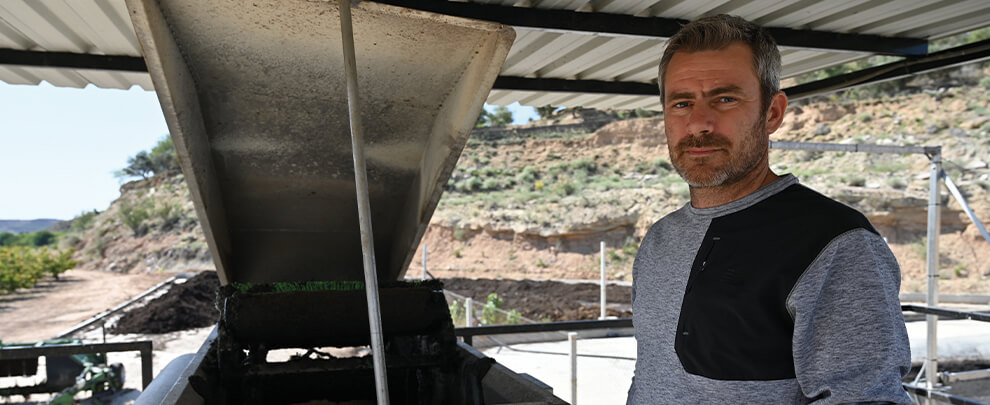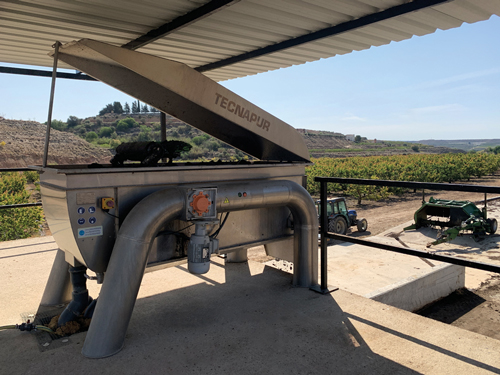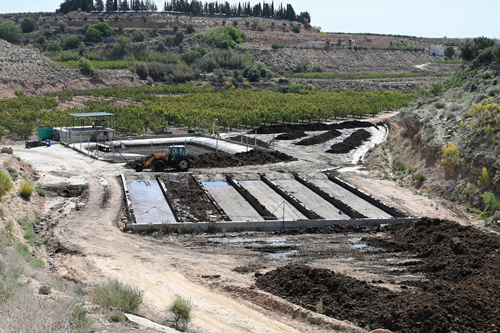Blog
Blog

F. Bieto: “We installed Tecnapur to make better use of the slurry”
13th July 2023 - Success stories
The Faixamata farm located in Seròs (Lleida) has been working since 2021 with the Tecnapur slurry management system. The installation of the mechanical separator (phase 1) and the physicochemical reactor (phase 2) on the farm have allowed it to transform the solid part of the slurry into an organic compost for the company’s agricultural farms, and take advantage of the liquid part in the drip irrigation system of these. To find out what the daily work they do with Tecnapur is and the results they obtain from the slurry management, we spoke with Faustino Bieto, responsible for the agricultural farms of Faixamata.
How is the farm distributed?
The Faixamata farm was built more than 40 years ago as a business alternative to agriculture. Over the years, the animal tally has increased to currently have four buildings for fattening. Specifically, we have a warehouse with a capacity for 800 pigs, two of 1,200 and one of 1,500.
How many people work on the farm?
We are two people. An employee is in charge of the management of pigs and Tecnapur equipment, and I am in charge of the management and administrative aspects.
Why did you decide to install the Tecnapur slurry management system on the farm?
Mainly, to make better use of the solid and liquid parts we obtain from the slurry to fertilize our agricultural farms. The problem we had was the slurry extraction, as well as its management and all the limitations that occur when it’s applied to the fields directly. With the installation of Tecnapur Phase 1 and Phase 2, we can overcome these problems.

Solid-liquid separator. Foto: Rotecna.
What is the slurry management process that you perform?
All the farms are connected to the slurry swamp, from where we pump the slurry into the separator (phase 1). From there we remove the solid parts and send the liquid to the physicochemical reactor (phase 2), where a separation of the sludge from the liquid part happens. The latter is sent to a gathering pool to be used for drip irrigation of the farms. As for the solid part we obtain, we use it as composting by distributing it through the new farms, since it helps us with humic and fulvic acids, and to maintain optimal moisture in the soil and not let salinity rise in the ground.
What are the results of this management process in figures?
We treat about 50-55 cubic meters of slurry per day. Regarding the volume of initial slurry, in phase 1 we obtain 5% of solid matter, which we reserve for composting. In phase 2, we obtain 75% sludge, which we take to the drying pools and then compost with the solid part of phase 1, and 20% liquid part that we send to the pond for irrigation.
Economically, what is the cost per cubic meter of slurry separation?
The cost of this system is about 2.5 – 3 euros / cubic meter, counting electricity, labour and necessary products for its operation. Compared to the costs we had to remove the slurry with vats, it is a significant reduction in costs. Approximately 1 euro difference per cubic meter.

General view of the slurry treatment area, with the drying pools, the slurry pond, the separator and phase 2 of Tecnapur. Photo: Rotecna.
In Faixamata you have opted for the installation of the two phases of the Tecnapur system, what is the advantage?
For us, the main advantage in the management of slurry is to work with the two phases of Tecnapur together, since this allows us to take advantage of the solid part that comes out of the separator as organic composting, increasing its volume with the solid part that we obtain after drying the sludge that comes out of phase 2 (physicochemical reactor). And then, another great advantage of working with the two phases is the liquid part that we obtain from phase 2, which we take advantage of to infuse into the drip irrigation system that we have on the farms. In addition, now, even in a period of drought like the one we are experiencing, it is helping us to be able to irrigate our farms without problems.
How is the daily work with the Tecnapur system?
The operation of the Tecnapur system is very simple and basic. What we do daily is to visually control it, so that everything is working properly, that the acids and flocculant deposits are at the correct level and that’s it. It is a system that has no difficulty and the time invested is minimal.
What would you highlight about the service offered by Rotecna?
They offer us a very good service. The truth is that whenever we have any doubts, it has a very good technical assistance helpdesk, which answers immediately.
What future challenges does the farm face?
We currently do not have any expansion projects, so for now we are working to maintain production and continue to carry out a good slurry management to take advantage of both the solid and liquid parts we obtain, with which we are really satisfied.






